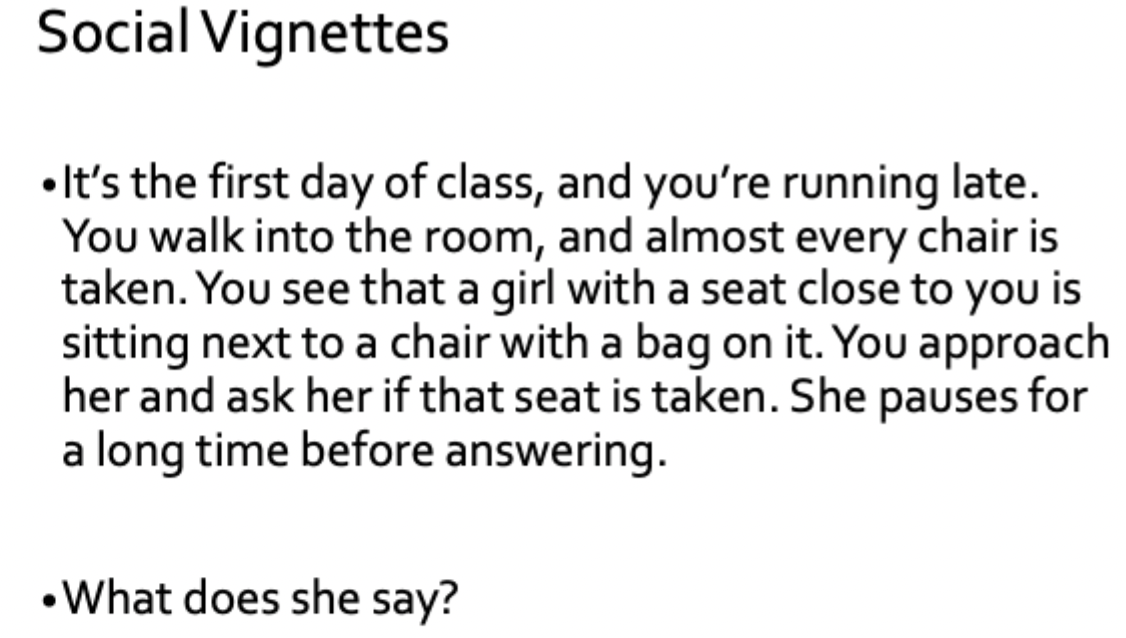4 - GAD & SAD
1/31
There's no tags or description
Looks like no tags are added yet.
Name | Mastery | Learn | Test | Matching | Spaced |
|---|
No study sessions yet.
32 Terms
DSM-III def of GAD
DSM-3 lumped it into broad category of anxiety “neurosis”
In DSM-3; GAD broke out into "waste basket" (residual category) but didn't fit criteria for other disorders
DSM-III-R(evised) on GAD (4)
DSM-3-R changed (*allowed) for GAD to have more of its own identity
worry began to play a larger role
patholgical worry—*worry has to be about everyday situations, not just about another disorder *for GAD?
sometimes difficult differential diagnosis
DSM-IV (four) on GAD (7)
simplified the critiera *for GAD
EXCESSIVE anxiety and worry *Lvl of anxiety/worry higher than the worry called for
*time/context critieria: more days than not, at least 6 months *need to see this excessive worry present for at least 6 months
worry about multiple events, activities, objects — difficult to control the worry
cannot occur exclusively during a mood episode
DSM-5 critiera (criterion A and criterion B)
criterion A: uncontrollable & persistent worry
crtierion B (6): 1)restless, feeling on edge, 2)easily fatigued 3) difficulty concentraing
4)irritabliity 5)muscle tension 6)sleep distrubance
—symptoms must cause significant distress or impairment *you need criterion A and, need 3/6 criterion B symptoms for GAD diagnosis
GAD’s overlap with depression
GAD is almost ALWAYS comorbid with smth else (more than other disorders
*very comorbid with depression
*Overlap with depression -- 4 symptoms formerly: Feeling restless, Muscle tension, worry, sleep disturbance?
*debate: is GAD a variant of MDD or a distinct disorder? So there’s lots of controversy over GAD
NA and GAD as vulnerability marker (3)
being very anxious & having lots of negative affectivity (NA) common for these types of disorders *GAD, depression?
So GAD as vulnerability marker; fundamental personality marker that predisposes ppl to other disorders
Vulnerability marker: GAD interferes with ability to have strong relationships, have 'bad world' view, etc.
prev of GAD — lifetime, 12-month, gender, etc. (4)
5-6% lifetime
12-month prevalence: 3.1%
2F:1M *Twice as common in women (compared to men)
most commonly diagnosed Axis 1 disorder in primary care *Ppl who present to primary care physician with stomach problems, migraines, etc, get anxiety disorder (GAD) diagnosis
GAD comorbidity (3)
as many as 90% of diagnosed cases meet critiera for another disorder
as many as 80% of diagnosed cases meet critteria for a mood diorder *GAD very comorbid with other mood disorders
also panic disorder, social anxiety disorder, personality disorder *So not exclusively comorbid with MDD (mood disorders) also extensively comorbid with anxiety and personality disorders
problems with GAD (3)
associated with increased health care utilization—more frequent visits to doctor *Ppl with GAD make more trips to doctor, emergency room, etc.
increased health care costs—greater chance of concurrent physical illness *but do ppl that have illnesses experience increase of GAD or vice versa? (debate)
and significant social, academic, & vocation impairment—days lost at work/school, damage to/difficulty with relationships
onset of GAD (4)
GAD symptoms often evident in adolescence or earlier
median age of onset in the 30s *what age is most typical for diagnosis, but kids can be diagnosed with it before then, & this median age is creeping earlier present day
but can onset at any time
gradual onset *Bc signs and symptoms are evident early on there is gradual onset: Not like ur fine one day and then really w/ anx bad the next, there is a ramping up onset over time (gradual)
course of GAD (4)
chronic course *Ppl with GAD tend (even after symptoms improve) have higher levels of worry and negative affectivity than the average person
personality disorder *arguably a personality disorder (debate)
12-yr follow up study, the recovery rate is 58% from GAD *over half of ppl will recover
BUT of those who recover, the recurrence rate is high *tho may recover, huge number of them had a recurrence of GAD
*Recurrent nature of GAD: ppl often get disorder (may recover) and then have another episode of GAD (relapse)
familial transmission of GAD (3)
trait anxiety is HIGHLY familar *Parents who are high trait anxious have kids that are trait anxious: more higher than on average in anxiety
strong genetic component *Strong genetic component of additive genetic contribution for anxiety (based on twin and adoption studies)
GAD also runs in families
family studies findings of GAD (3)
family studies find:
increased rates of GAD in families of probands w/ GAD *GAD runs in families
*If find proband (patient) with GAD and then assess fam members of that proband, you find higher rates of GAD in that proband than in the general pop (without anxiety)
higher rates (of GAD in probands w/ anxiety) than in probands w/ panic disorder
this suggests some specificity *of GAD
prototypical anxiety disorders VS GAD (5)
GAD vs. Phobias: Unlike “protoypical” anxiety disorder or phobias, GAD doesn't have a specific object of fear (e.g., spiders).
‘feared object’ in GAD: fear is of emotional experience/emotions themselves—negative emotions & maybe excessive excitement.
emotional experience: fear stems from worrying about emotions/ thoughts, and the physiological responses to them.
catastrophizing: ppl with GAD often worry about their anxiety itself, fearing it will overwhelm them (e.g., “worrying too much will harm me”).
vicarious transmission: anxiety can be learned from others' anxious responses (ex. Anna’s (prof’s) father worrying about her anxiety)
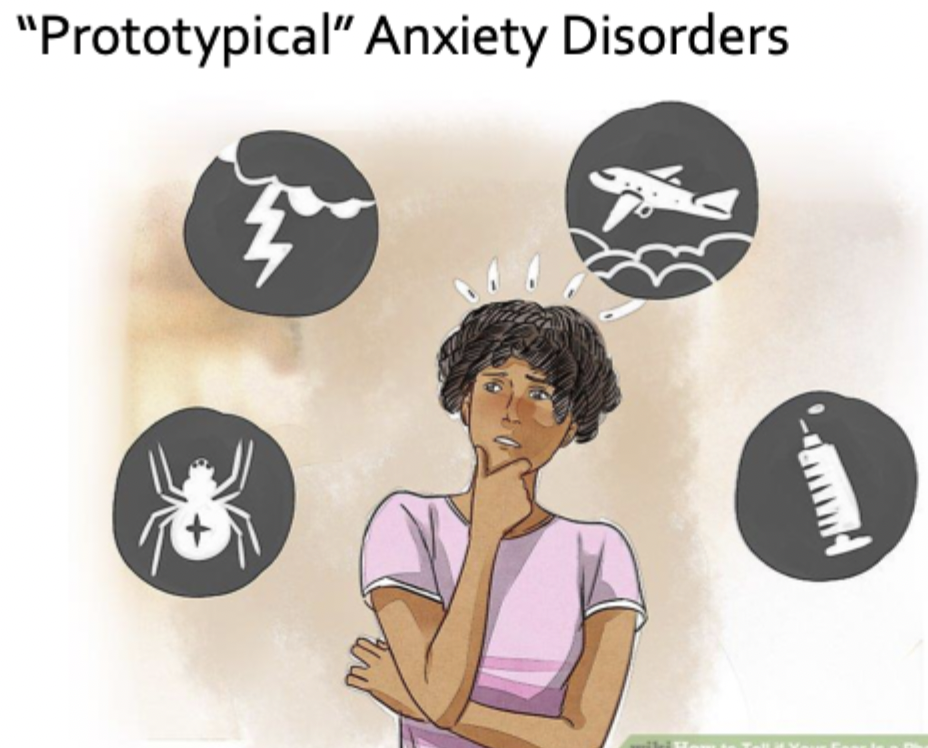
Tom Borkovec’s theory of GAD (4)
most prominent current theory of GAD comes from Tom Borkovec
Borkovec: worry is a form of cognitive avoidance strategy
—and like all avoidance is negatively reinforced *in avoiding feared situation, this strengthens the relationships btwn worry leading to relief
ppl *w/ anx worry about low probability events (ex. Ex. "I haven't' heard from my son in a while, is he dead?" '
*—so they engage in higher lvl activity of worry (ex. Last time I hear was 12;15 but if I don't hear from her in a hour who knows what could happen, I'll start to organize regular check ins)
*These cognitive avoidance strategies allow you to avoid the emotional experiences—you engage in these activities to prevent a disaster of (ex. Your son's death happening—a low prob event; an event very unlikely to occur *and relief comes from these low probabilty events not happening, but this negatively reinforces the cycle?
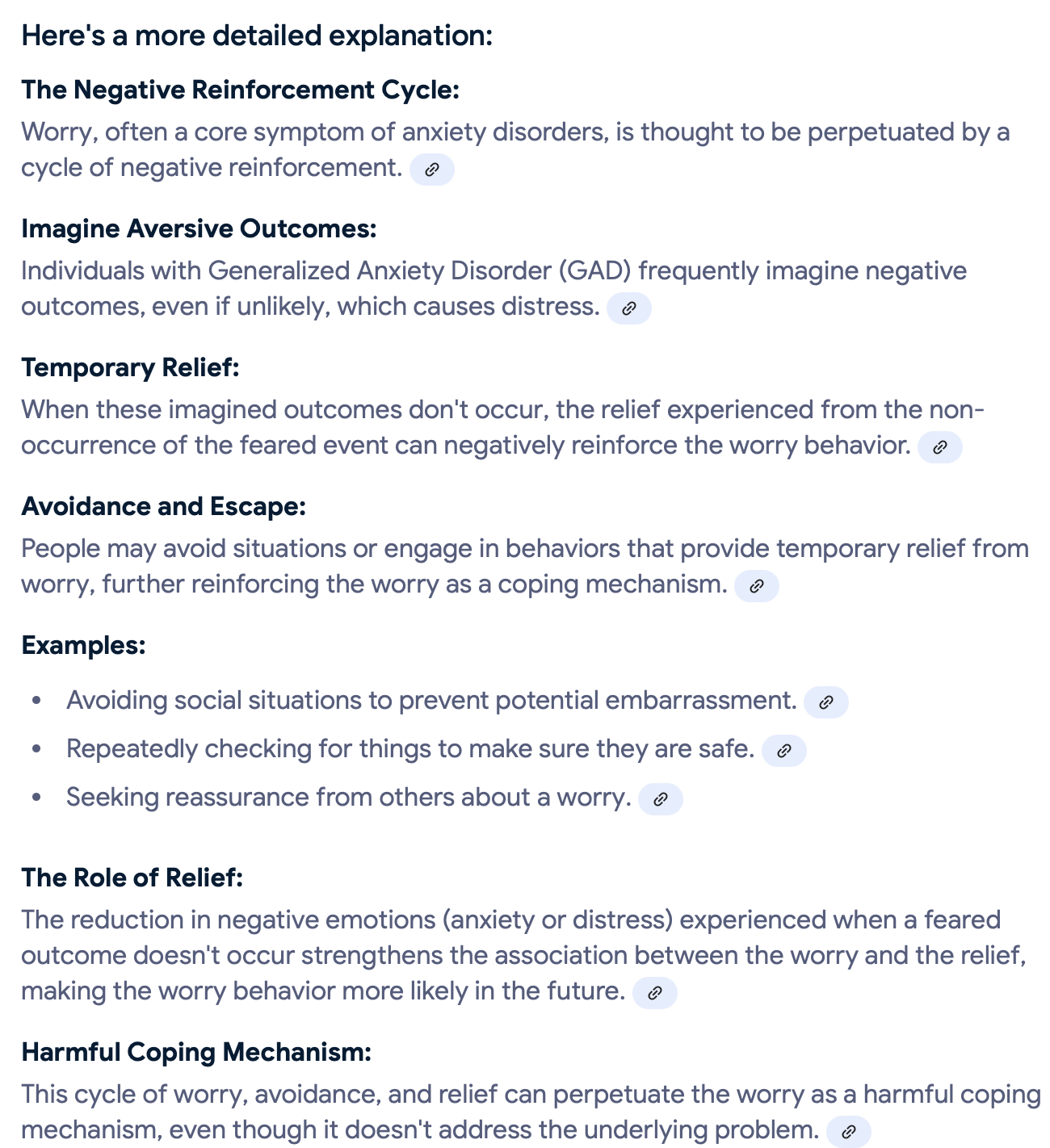
Borkovec on worry & imp of vivid imagery/emotional arousal(5)
worry = cognitive, verbal and mental operation
worry buffers from high emotional arousal & inhibits emotional processing
—when worried, we don’t get vivid imagery *(of the stimuli we are worries about ex. son dying) BUT you need that vivid imagery to become emotionally aroused *you need habituation to the fear: realize you can survive feeling fear (ex. recognize worry not worth destroying relationship with my daughter)
bc if never aroused, you can never change you fear structure
—imp of exposure therapy
GAD & cycle of worry: thought suppression & control (4)
also evidence that GAD tries to control/supress the worry
vicious cycle—1)inability to control worry 2)increases sense of lack of control, and this 3)increases intrusiveness of thoughts *about worry?
so the cycle perpetuates itself
white bear experiment—*thought suppression: the more you try to stop thinking about a white bear (supress a thought), the more you think about a white bear (about that thought) *instrusivness of that thought increases
thought suppression (‘4 steps’)
Have intrusive thoughts
Then suppress that intrusive thought
Then more bad thoughts/cascade of thoughts come in (and it takes more effort to stop thinking of bad thoughts)
4. Then thinking about the worst thing that would happen—not what happens if (ex. You do stop loving your mom)
cognitive factors and GAD (4)
Ppl with GAD have abnormal attentional biases
will be more likely to pay more attention to threatening stimuli and for a longer period of time compare to non-threatening stimuli (px. Ppl with GAD will look at snake faster and pay more attention to it (than flower))
have attentional biases even for ambiguous stimuli (ex. When face VS snake, will look at snake for longer)
—Neutral faces: ppl with GAD and social anxiety disorder will look at a neutral face more than a happy face and be more likley to see a neutral face as negative, so think even an ambigious face represents a low lvl of threat
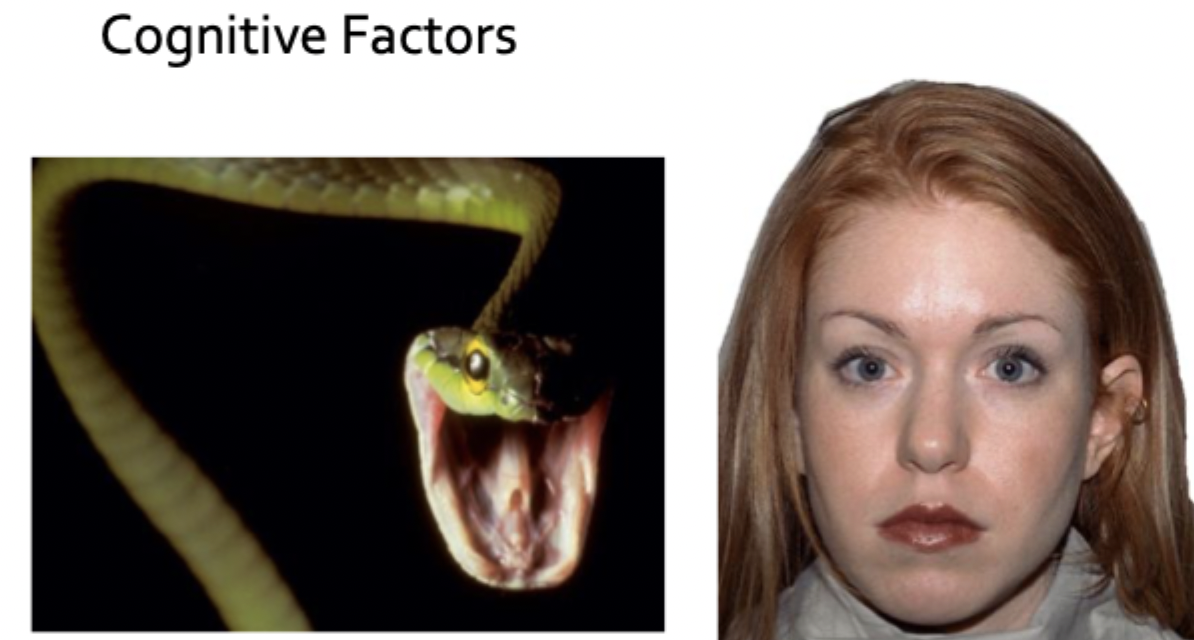
ambigious word stems GAD (3)
ambigious word stems: ends of ambiguous words are left blank
Ppl with GAD are more likely to fill in ambiguous word stems with negative words— ex. death, funeral, pain, harassment
Easier for them to generate threatening content
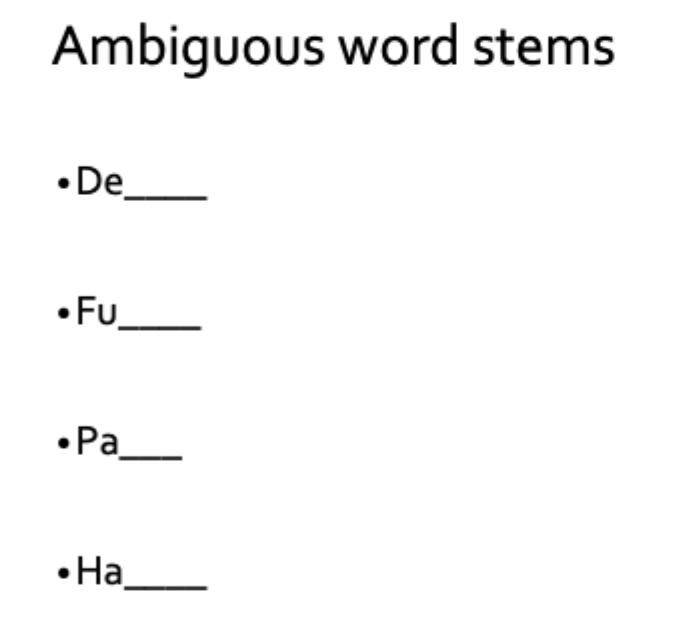
worry VS rumination
Worry and rumination are both repetitive thought patterns that can involve negative thinking and feelings.
difference in temporal focus: worry=future oriented, rumination: retrospective (thinking about the past)
rumination: tendency to go back to smth you did wrong over and over again (keep thinking about it), very common in MDD (trying to solve a problem that happened in the past)
worry: future-oriented, aimed at preventing disasters from happening in the future
social anxiety (3)
2nd most common anxiety disorder *after GAD (which is the most common anx disorder)
3rd most common psychiatric disorder
impairment: romantic relationships, other social relationships, career & education
DSM-5 criteria for social anxiety disorder — criterion A-G
a)Fear or anxiety about social situations *F(ears)N(-) PEO(ppl)
b) Concern about being negatively evaluated (i.e. will be humiliating or embarrassing; will lead to rejection or offend others.:
c)The social situations almost always provoke fear or anxiety
d)The individual avoids or endures the situations with great distress (anxiety)
e)The fear or anxiety is out of proportion to the actual threat posed by the social situation and sociocultural context
f & g)*fear, anxiety, or avoidance lasts at least 6 months AND fear or anxiety causes significant distress or functional impairment (for DSM-5 diagnosis)
*all criteria A-E) MUST be met for diagnosis
type of fears in social anxiety disorder (5)
fears often involve specific situations (such as):
speaking in public
eating in public
writing in front of other ppl
using public bathrooms—slightly more common in men *fear of performance
also generalized social phobia—multiple situations are feared or avoided *this is most common
prev of social anxiety (4)
social anxiety lifetime prev: 12% *very common, again 2nd most common disorder after specifc phobias
2F:1M *Twice as common in women than in men
—gender differences emerge in adolescence *~around age 15
comorbidity very high *Very comorbid with other anxiety and depression
self-oriented characteristics of ppl with social anxiety (4)
social anxiety disorder: high standards, very self-critical, tend to scrutinize themselves
*Have punishingly high standards of themselves
Self-critical: constantly scanning themselves and actions for imperfections —ppl w/ SAD always scrutinize themselves
high self-criticism in depression *we also see this lvl of self-criticism in depression (but not formal criteria) and this may explain some of the overlap btwn depression and social anxiety
racial/ethnic differnces in social anxiety (4)
rates similar in north & south amercia *Rates are similar in south, north American and in most of europe, but lower rates in east Asian countries
prev far lower in East Asian countries—less than 1% 1-yr prev (compared to 6-7 1 yr prev in North America)
east asian race/ethnicty associated with low prevalence in north america as well
in North American samples, hispanic or black ethicity also associated with lower risk compared to non-hispanic white
are these racial/ethinic diffences genuine differences in psychopathology? (3)
*what is the validity? Is this a genuine difference in psychopathology
insufficient considerations of cultural aspects of the DSM criteria, assessment instruments, or infleunce of features associated with race, ethnicity and culture
*Not enough consideration for other cultural factors
Ex. Taijin Kyofusho—worry about embarrassing another person, variant of social anxiety but more common in Japanese and Korean cultures (ex. worried about bad body odour bc don't want to offend/embarrass ppl with their body odor)
*if we use measures assessment made in one cultural context, we may fail to capture the phenomena appropriately in another culture
age of onset for some specifc phobias VS social phobia (aka social anxiety disorder) (4)
animal phobias: mean age of onset: 7
blood and injury: 9 yrs
dental phobias: 11 yrs
social phobia: 16 yrs
*RE from psyc 412: phobias become more complex as kids age
cognitive theories of social phobia (6 ‘steps’)
social situations activate core set of values or beliefs—RE: social competencies *Ppl with social anxiety disorder have a core set of beliefs: ex. think of self as profoundly socially incompetent, I'm boring, no one likes my stories, nobody likes, etc.
—(that tell them/make them) believe others wil view them negatively *and this influences how they perceive info:
schemas interfere with interpretations of social situations
begin to see danger and threat *they go into situation focusing on ‘threat’ and ex. person they're talking to has neutral expression: this reaffirms to person with social anxiety, nobody likes me, etc. (but for all they know, they person had their head in the clouds, not paying attention)
the more anxious they feel, the more likely they think rejection is
this makes them (even) more anxious
how is SAD maintained (5)
self-focus (as safety behaviour) that maintains SAD
functions as “safety”/avoidance behaviour *Intense self scrutiny is form of avoidance bc you don't have ot look at other ppl and you just focuse on yourself
used to forestall social disasters *by focusing on self, they can control what happens to them so the disaster they're afraid of ‘doesn't happen’
*BUT intense focus on self interferes with ability to be socially competent: less adept at having social interaction bc they don't actually LISTEN to what the other person says (only about what they themselves are taking about)
even after situation, a biased memory for negative experiences *(ex. biased memory: only remember s/o’s negative emotions, not the 13 smiles they gave)
reinforces negative expectation of self— vicious cycle
social vignettes
can be used to test for social phobia
those with more intense social phobia more likly to anticiapte negative reaction from other ppl during interactions
